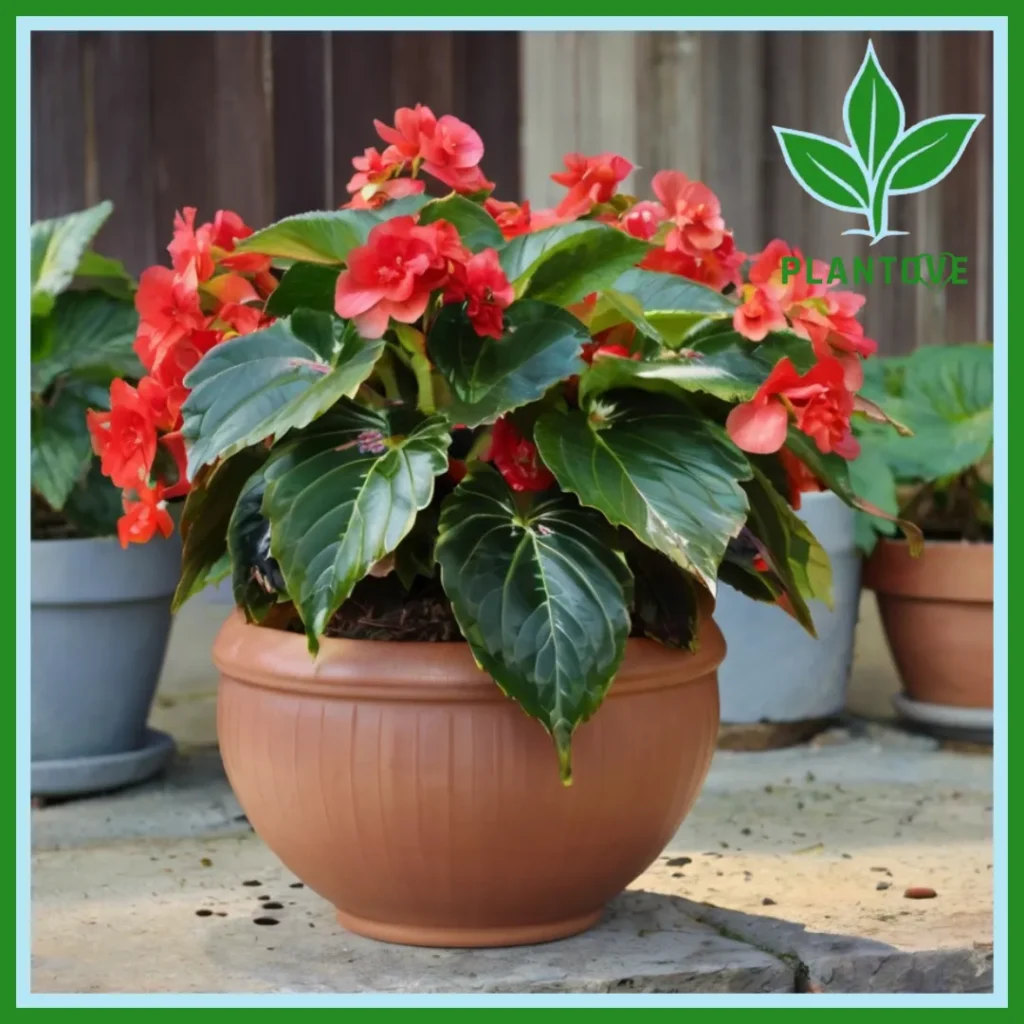The Dragon Wing Begonia is a captivating plant that has captured the hearts of gardeners and plant enthusiasts across the United States. With its lush green foliage and vibrant, drooping flowers, this hybrid begonia variety adds a touch of elegance to any indoor or outdoor space. Whether you’re an experienced gardener or just starting, understanding how to care for and propagate Dragon Wing Begonias can help you create a thriving garden that showcases their beauty.
In this comprehensive guide, we’ll explore everything you need to know about Dragon Wing Begonias, including their characteristics, care requirements, and how to propagate them successfully. We’ll also discuss whether they are perennial or annual plants, making it easier for you to decide how to incorporate them into your gardening plans.
What is a Dragon Wing Begonia?
The Dragon Wing Begonia (Begonia x hybrida) is a hybrid variety that is known for its attractive, wing-shaped leaves and continuous blooming habit. The plant produces an abundance of large, drooping flowers that come in shades of red or pink, creating a stunning display throughout the growing season.
This particular begonia is characterized by its thick, glossy leaves that can reach up to 6 inches in length, making them an eye-catching addition to any garden. Dragon Wing Begonias are typically grown as ornamental plants, and they can thrive in both containers and garden beds.
Features of Dragon Wing Begonia
- Leaf Shape: The leaves are uniquely shaped like wings, with a glossy surface and serrated edges.
- Flowering Habit: Dragon Wing Begonias produce clusters of flowers that bloom continuously from spring through fall.
- Growth Habit: This begonia has a trailing or cascading growth habit, making it ideal for hanging baskets and containers.
Is Dragon Wing Begonia Perennial or Annual?
One of the most common questions regarding Dragon Wing Begonias is whether they are perennial or annual plants. The answer largely depends on your climate zone.
In Warmer Climates
In USDA hardiness zones 9 through 11, Dragon Wing Begonias can be grown as perennials. They can survive the winter months and will bloom again in the spring, given that they are protected from frost. In these regions, gardeners can enjoy the beauty of Dragon Wing Begonias year after year with proper care.
In Cooler Climates
For those living in colder climates (zones 7 and below), Dragon Wing Begonias are treated as annuals. They will not survive freezing temperatures, so they must be replanted each year. If you want to keep them over the winter, you can bring them indoors before the first frost. They make excellent houseplants when grown in pots.
Dragon Wing Begonia Care

Caring for Dragon Wing Begonias is relatively straightforward, making them an excellent choice for both novice and experienced gardeners. Below are essential care tips to help your Dragon Wing Begonia thrive.
Light Requirements
Dragon Wing Begonias prefer bright, indirect light but can tolerate partial shade. When growing them indoors, place them near a window that receives filtered sunlight, such as an east or north-facing window. Too much direct sunlight can scorch their leaves, while too little light can result in fewer blooms.
When growing outdoors, choose a location that receives dappled sunlight or light shade, especially during the hottest part of the day.
Watering Needs
Proper watering is crucial for the health of Dragon Wing Begonias. These plants prefer consistently moist soil but are susceptible to root rot if overwatered. Here are some guidelines for watering:
- Check Soil Moisture: Before watering, stick your finger into the soil about an inch deep. If it feels dry, it’s time to water.
- Watering Schedule: During the growing season (spring and summer), water your Dragon Wing Begonia regularly. Allow the top inch of soil to dry out between waterings.
- Reduce Watering in Winter: In the winter months, when the plant is not actively growing, reduce your watering frequency. Let the soil dry out more thoroughly between waterings.
Soil Requirements
Dragon Wing Begonias thrive in well-draining, nutrient-rich soil. A good potting mix specifically formulated for indoor plants works well. If planting in the garden, consider amending the soil with compost or organic matter to improve drainage and nutrient availability.
Fertilizing
To encourage lush growth and vibrant blooms, fertilize your Dragon Wing Begonia regularly during the growing season. Use a balanced, water-soluble fertilizer, following the instructions on the package for dilution rates. Fertilizing every 4-6 weeks during the growing season will provide the nutrients the plant needs.
Temperature and Humidity
Dragon Wing Begonias thrive in warm conditions. The ideal temperature range is between 65°F and 75°F (18°C to 24°C). They can tolerate higher temperatures but should be protected from extreme heat.
Pruning and Maintenance
Regular pruning helps maintain the health and appearance of your Dragon Wing Begonia. Here are some tips for effective pruning:
- Remove Dead or Yellowing Leaves: This will promote better air circulation and encourage new growth.
- Pinch Back Overgrown Stems: If the plant becomes leggy, pinch back the tips of the stems to encourage branching and a fuller appearance.
Propagating Dragon Wing Begonia
Propagating Dragon Wing Begonias is a rewarding process that allows you to expand your collection or share plants with friends. The most common method of propagation is through stem cuttings.
Steps for Propagation
- Select Healthy Stems: Choose healthy, non-flowering stems from your existing Dragon Wing Begonia. Aim for stems that are about 4 to 6 inches long.
- Make the Cut: Using a clean, sharp knife or scissors, cut the stem just below a node (the point where leaves emerge from the stem).
- Prepare the Cutting: Remove any leaves from the bottom half of the cutting, leaving at least one or two leaves at the top.
- Rooting Hormone (Optional): Dip the cut end of the stem in rooting hormone to encourage faster root development.
- Plant the Cutting: Place the cutting in a pot filled with well-draining potting mix. Water lightly to settle the soil around the cutting.
- Create a Humid Environment: Cover the pot with a plastic bag or a clear plastic dome to maintain humidity. Ensure the plastic does not touch the leaves.
- Place in Indirect Light: Place the pot in a location with bright, indirect light and keep the soil consistently moist.
- Transplanting: After a few weeks, check for root development by gently tugging on the cutting. Once roots have formed, you can transplant it into a larger pot or directly into the garden.
Tips for Successful Propagation
- Timing: The best time to propagate Dragon Wing Begonias is during the spring or early summer when the plant is actively growing.
- Patience: It may take several weeks for cuttings to develop roots, so be patient during the process.
Common Problems and Solutions
While Dragon Wing Begonias are generally easy to care for, they can encounter some common problems. Here are some issues you might face and how to address them.
Leaf Yellowing
If the leaves of your Dragon Wing Begonia turn yellow, it could be a sign of overwatering or poor drainage. To remedy this, check the soil moisture and ensure the pot has adequate drainage. Adjust your watering schedule accordingly.
Leggy Growth
Leggy growth often results from insufficient light. If your Dragon Wing Begonia appears stretched or sparse, move it to a brighter location to encourage fuller growth.
Pests
Dragon Wing Begonias can attract pests such as aphids, mealybugs, or spider mites. Regularly inspect your plants for signs of pests. If you notice an infestation, treat it with insecticidal soap or neem oil.
Fungal Issues
Overwatering can lead to fungal problems, such as powdery mildew. Ensure proper air circulation around the plant and avoid watering the leaves. If you notice any fungal issues, apply a fungicide to treat the affected areas.
Conclusion
The Dragon Wing Begonia is a striking and versatile plant that can enhance any garden or indoor space. With its vibrant blooms, lush foliage, and relatively easy care requirements, it is a fantastic choice for gardeners in the USA. Understanding whether to treat it as an annual or perennial, along with proper care and propagation techniques, will help you enjoy this beautiful plant for years to come. By incorporating Dragon Wing Begonias into your gardening routine, you’ll be rewarded with a stunning display that brings joy and color to your surroundings.

